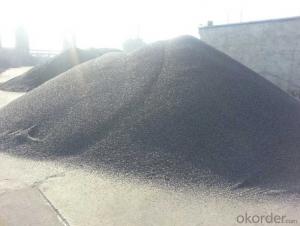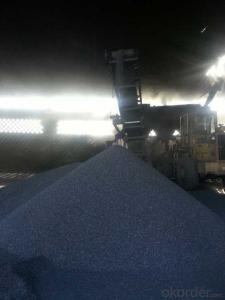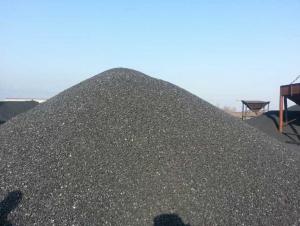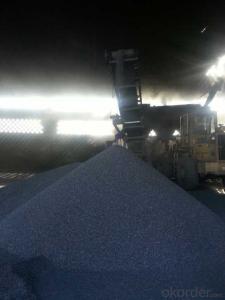Gas Calcined Anthracite FC90-95 with stable quality
- Loading Port:
- Tianjin
- Payment Terms:
- TT OR LC
- Min Order Qty:
- 20 m.t.
- Supply Capability:
- 3000 m.t./month
OKorder Service Pledge
OKorder Financial Service
You Might Also Like
Packaging & Delivery
25kgs/50kgs/1ton per bag or as buyer's request
Specifications
Calcined Anthracite
Fixed carbon: 90%-95%
S: 0.5% max
Size: 0-3. 3-5.3-15 or as request
It used the high quality anthracite as raw materials through high temperature calcined at over 2000 by the DC electric calciner with results in eliminating the moisture and volatile matter from anthracite efficiently, improving the density and the electric conductivity and strengthening the mechanical strength and anti-oxidation. It has good characteristics with low ash, low resistvity, low sulphur, high carbon and high density. It is the best material for high quality carbon products.
Advantage and competitive of caclined anthracite:
1. strong supply capability
2. fast transportation
3. lower and reasonable price for your reference
4.low sulphur, low ash
5.fixed carbon:95% -90%
6..sulphur:lower than 0.3%
General Specification of Calcined Anthracite:
| FC | 95 | 94 | 93 | 92 | 90 |
| ASH | 4 | 5 | 6 | 6.5 | 8.5 |
| V.M. | 1 | 1 | 1 | 1.5 | 1.5 |
| S | 0.3 | 0.3 | 0.3 | 0.35 | 0.35 |
| MOISTURE | 0.5 | 0.5 | 0.5 | 0.5 | 0.5 |
Pictures

We are also strong at below materials, please contact us if you are interested in any of them:
Calcined Petroleum Coke
Carbon Electrode Paste
Carbon Electrode
- Q: How is carbon used in the production of lubricants?
- Carbon is used in the production of lubricants as it forms the base of many lubricant formulations. Carbon compounds, such as hydrocarbons, are used as the primary ingredient in lubricants to provide lubricating properties. These compounds help reduce friction and wear between moving parts, thus improving the efficiency and lifespan of machinery and equipment.
- Q: How does carbon affect the stability of ecosystems?
- Carbon plays a crucial role in the stability of ecosystems as it is a key component of all living organisms. It affects stability primarily through the carbon cycle, where it is exchanged between the atmosphere, plants, animals, and soil. Carbon dioxide, a greenhouse gas, regulates the Earth's temperature and climate. Excessive carbon emissions from human activities, such as burning fossil fuels, contribute to climate change, which disrupts ecosystems and poses risks to biodiversity, water resources, and food production. Additionally, carbon is essential for photosynthesis, the process by which plants convert CO2 into oxygen and organic compounds, supporting the entire food chain. Hence, its availability and balance are essential for maintaining the stability and functioning of ecosystems.
- Q: What are the impacts of carbon emissions on the stability of mangroves?
- Mangroves, crucial coastal ecosystems, are negatively affected by carbon emissions, which have detrimental effects on their stability. The increased levels of carbon dioxide (CO2) in the atmosphere contribute to global warming, resulting in rising sea levels and more frequent and intense storms. These changes directly impact mangroves in several ways. Firstly, global warming causes rising sea levels, leading to more frequent inundation of mangroves. As the sea level rises, saltwater intrusion occurs more often, disrupting the delicate balance of saltwater and freshwater in mangrove ecosystems. This can displace and cause a decline in mangroves, as they struggle to adapt to the changing conditions. Secondly, the increased frequency and intensity of storms due to climate change can physically damage mangroves. Mangroves act as a natural barrier, absorbing wave energy and protecting coastlines from storm surges. However, stronger storms test the resilience of mangroves, potentially uprooting or destroying them, leaving the coastlines vulnerable to erosion and further damage. Additionally, carbon emissions are linked to ocean acidification, which occurs when excess CO2 is absorbed by the oceans. Acidic waters negatively impact the growth and development of mangroves, as they are sensitive to changes in pH levels. This can lead to reduced productivity, stunted growth, and even death of mangroves, further destabilizing these ecosystems. The stability of mangroves is crucial for both the environment and human populations. Mangroves provide essential habitats for various species, acting as a nursery for fish and supporting biodiversity. They also serve as carbon sinks, absorbing significant amounts of CO2 from the atmosphere. Furthermore, mangroves play a vital role in coastal protection, mitigating erosion, storm surges, and flooding impacts. To mitigate the effects of carbon emissions on mangrove stability, it is crucial to reduce greenhouse gas emissions and limit global warming. This can be achieved by adopting clean energy sources, implementing conservation efforts, and initiating reforestation projects. Equally important is the protection and restoration of mangrove habitats, as this helps maintain their stability and resilience to climate change impacts.
- Q: How does carbon affect food production?
- Carbon affects food production in several ways. Firstly, carbon dioxide is a crucial component for photosynthesis, the process by which plants convert sunlight into energy. Increased levels of atmospheric carbon dioxide can potentially enhance crop yields by providing plants with more raw materials for growth. However, excessive carbon emissions are also responsible for climate change, leading to extreme weather events such as droughts, floods, and heatwaves, which can negatively impact food production. Additionally, the burning of fossil fuels releases carbon dioxide, contributing to air pollution that can harm crops and reduce their productivity. Therefore, while carbon is essential for plant growth, the excessive release of carbon emissions can have detrimental effects on food production.
- Q: What are the consequences of increased carbon emissions on public health systems?
- Increased carbon emissions have significant consequences on public health systems. One of the most prominent effects is the exacerbation of respiratory diseases such as asthma, chronic obstructive pulmonary disease (COPD), and bronchitis. Carbon emissions contribute to the production of fine particulate matter (PM2.5) and ground-level ozone, both of which can penetrate deep into the respiratory system and cause or worsen these conditions. Moreover, higher levels of carbon emissions are correlated with an increased prevalence of cardiovascular diseases. Fine particulate matter and other pollutants released from carbon-emitting sources can enter the bloodstream, leading to inflammation, oxidative stress, and the development of atherosclerosis. Over time, this can result in heart attacks, strokes, and other cardiovascular complications. Climate change, driven by carbon emissions, also impacts the spread of infectious diseases. Rising temperatures and altered precipitation patterns create favorable conditions for the expansion of disease vectors like mosquitoes and ticks, leading to the transmission of diseases such as malaria, dengue fever, Lyme disease, and Zika virus. Additionally, extreme weather events and natural disasters associated with climate change can disrupt healthcare infrastructure and compromise access to essential services, further impacting public health systems. Furthermore, mental health is also affected by increased carbon emissions. The environmental degradation caused by carbon emissions contributes to feelings of anxiety, stress, and depression, often referred to as eco-anxiety or climate grief. The loss of biodiversity, destruction of natural habitats, and the overall uncertainty surrounding the future can have detrimental effects on individuals and communities, requiring additional resources and support from public health systems. In summary, increased carbon emissions have far-reaching consequences on public health systems. They contribute to the prevalence of respiratory and cardiovascular diseases, facilitate the spread of infectious diseases, and impact mental health. Addressing carbon emissions and implementing sustainable practices are essential to mitigating these consequences and safeguarding the well-being of individuals and communities.
- Q: What are the impacts of carbon emissions on the stability of river ecosystems?
- The stability of river ecosystems is significantly affected by carbon emissions, which have various consequences. One of the main outcomes of carbon emissions is the rise in greenhouse gases in the atmosphere, resulting in global warming. This increase in temperature directly and indirectly impacts river ecosystems. To begin with, higher temperatures can modify the physical characteristics of rivers and impact the availability of oxygen in the water. Warmer water holds less dissolved oxygen, which can be harmful to aquatic organisms like fish and invertebrates that depend on oxygen for survival. The decrease in oxygen levels can lead to a decrease in biodiversity and even cause fish to die. Furthermore, climate change caused by carbon emissions can disrupt the natural hydrological cycle. Changes in precipitation patterns can lead to droughts or floods, causing fluctuations in river flow. These alterations can affect the reproductive and migration patterns of many aquatic species, disturbing their life cycles and reducing their populations. Additionally, modified river flows can also affect the stability of riverbank and riparian habitats, resulting in erosion and habitat loss. Moreover, increased carbon emissions contribute to ocean acidification. When water absorbs carbon dioxide, it forms carbonic acid, which lowers the pH of the water. Acidic waters can have harmful effects on aquatic life, including shellfish, corals, and other organisms that calcify. River ecosystems are interconnected with coastal and marine ecosystems, so the consequences of ocean acidification can indirectly impact river ecosystems through the food chain. Furthermore, carbon emissions contribute to the deposition of air pollutants, such as nitrogen and sulfur compounds, onto land and water bodies. These pollutants can be carried by rainfall into rivers, leading to increased nutrient levels and eutrophication. Excessive nutrients can cause harmful algal blooms, deplete oxygen levels, and create dead zones, further disturbing the balance of river ecosystems. In conclusion, the stability of river ecosystems is profoundly impacted by carbon emissions. Rising temperatures, altered hydrological cycles, ocean acidification, and increased nutrient levels all contribute to the degradation of these ecosystems. It is essential to reduce carbon emissions and adopt sustainable practices to mitigate these impacts and preserve the health and stability of river ecosystems.
- Q: 14 is the upper left corner of the mark, please answer a bit more detailed, thank you!
- Enter 14C, select "14", "point font" or "tool" button "superscript"".
- Q: What does "2T-250,1U-200@300" and "1Y-100" mean in carbon fiber cloth reinforcement?
- the indicates that the U type hoop is 200 wide and the spacing is 300; the 1Y-100 represents the width of the 100 width and each of the two sides of the beam. The units are mm.
- Q: What is carbon nanophotonics?
- Carbon nanophotonics is a field of study that focuses on the manipulation and control of light using carbon-based materials at the nanoscale level. It involves the development and exploration of carbon-based nanomaterials, such as carbon nanotubes and graphene, to design and fabricate devices that can interact with light in unique and advantageous ways for various applications in photonics and optoelectronics.
- Q: What's the difference between carbon steel pipes and stainless steel pipes and seamless steel tubes?
- As the name implies, carbon steel is made of carbon steel, forming mostly by welding, drawing, rolling, adopted the extrusion molding, and the steel tube drawing, rolling, extrusion molding are called seamless steel pipe welded steel pipe.
Send your message to us
Gas Calcined Anthracite FC90-95 with stable quality
- Loading Port:
- Tianjin
- Payment Terms:
- TT OR LC
- Min Order Qty:
- 20 m.t.
- Supply Capability:
- 3000 m.t./month
OKorder Service Pledge
OKorder Financial Service
Similar products
Hot products
Hot Searches
Related keywords
























